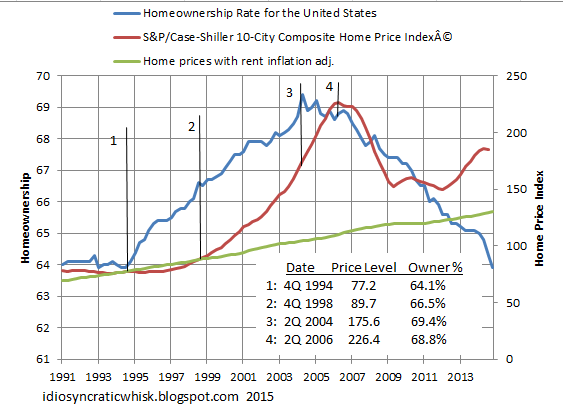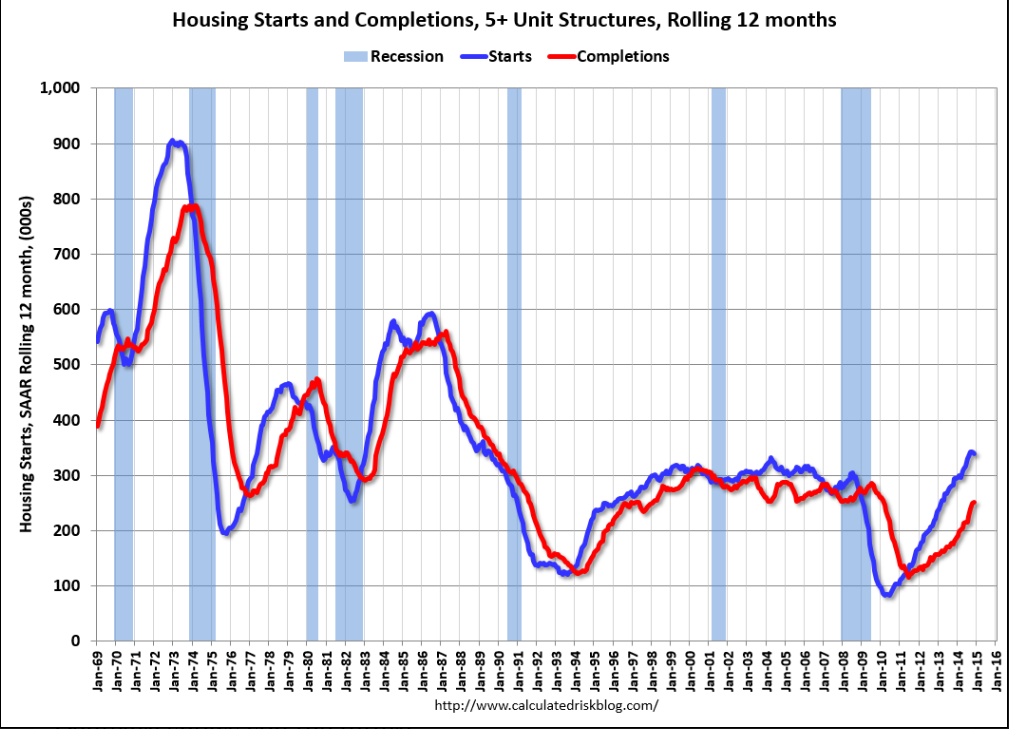Idiosyncratic Whisk Stock
Post on: 7 Апрель, 2015 No Comment

Wednesday, March 5, 2014
Stock/Bond Allocation (Part 5) — Modeling the Mortgage/Bond Hedge
After writing part 3. I decided to add a home & mortgage element to my historical data, to see if my intuition was correct. So, for each 20 year portfolio, I added to option of putting a 20% down payment down on a home, at portfolio inception.
Here are the effects this had on the presumed optimal asset allocation, where the 20-year outcome variance is estimated with the historical worst case scenario, which helps to account for the non-normal distribution of outcomes in the historical data.
The lines with white diamonds are the stock/bond (red) and stock/cash (green) portfolio allocation lines from the previous analysis. The light blue capital allocation line (CAL) identifies the optimal allocation for the stock/cash portfolio. As I described in the earlier post, bonds do not provide effective long-term hedging against stocks, so the optimal stock/bond allocation is to 100% stocks. Cash works a little better, so that a risk averse investor who does not want to allocate 100% to stocks can reduce risk more effectively with a cash allocation than she can with a bond allocation.
The lines with light gray diamonds and the blue CAL show the optimal allocations for a household that has purchased a house where the 20% down payment is 50% of the size of their at-risk portfolio. This reduces the risk in all efficient portfolios, with little change in the recommended allocations.
If the household purchases a home where the down payment is equal in size to their at-risk portfolio (dark gray diamonds and purple CAL), we see several changes. A house of this size no longer effectively improves the risk profile of the stock/cash portfolio. Now, the stock/bond portfolio is the optimal portfolio, and now the optimal portfolio holds a 20% bond allocation. Here, I think we are beginning to see the effective hedge between the long bond position in the at-risk portfolio and the short bond position represented by the mortgage on the home.
This becomes even more clear as the home increases so that the down payment is 150% of the at-risk portfolio. The combined performance of the home/stock/cash portfolio continues to decline. For the home/stock/bond portfolio, the optimal combined portfolio doesn’t perform quite as well as it does with a smaller home, but the home and the stock/bond portfolio do continue to provide hedging value, providing better returns than the household that doesn’t buy a home. And, the optimal at-risk portfolio in this scenario now holds around 50% of the portfolio in bonds.
I think the effectiveness of the mortgage/bond hedge is also visible in the way that the return-risk profile looks much more smooth and normal as the home allocation increases. In fact, at the 150% allocation to the home, the worst-case method of measuring risk actually recommends a larger bond allocation than the normal standard deviation does, suggesting that the mortgage somehow turns the persistency of bond market risks into an advantage. (I should note that I didn’t include rent savings as a benefit of home ownership in my model, which I don’t think effects the shape of these relationships much, but would generally cause the graphed returns of the home-owning households to be understated.)
I’m working with a pretty simple model, and it would take a lot more work to confirm all the details here. But, what this suggests is that a stock/cash allocation still seems most effective as an optimal long-term investing strategy. But, for households that use home ownership as a tool in their long-term savings strategy, especially in areas where high home prices require home equity to be a large portion of the household’s overall net worth, a significant bond allocation may be prudent. This is not as a hedge against the stock allocation, however. This is a hedge against the short bond position represented by the mortgage on the home. And, in this regard, it may be a very effective hedge.
In fact, this helps solve the transitional problem of moving from a long term, risk-seeking portfolio to a more risk-averse retirement portfolio. Looking at bonds as a hedge against the mortgage, a young household with a new house and a portfolio mixed between stocks and bonds would have a beginning exposure to a highly leveraged piece of real estate and a portfolio of stocks (the mortgage and bonds would roughly hedge away bond exposure). This is probably not a bad set of exposures for a young household. Over time, as the mortgage is paid down, the exposures would evolve, so that at the point where the mortgage is paid off, the household would have a comprehensive portfolio roughly split between unleveraged real estate, stocks, and bonds, which is probably a decent allocation for an older household.
This conception of the household lifecycle is dependent, though, on the behavior of real estate as a near cash asset. That has usually been the case, in the past, since, outside the 2000’s, either high inflation, high real long term interest rates, or a crippled credit market have limited entry into the homeowner’s market, reducing the convexity of home values relative to long-term real interest rates. This meant that if you could clear the hurdle to become a leveraged home owner, it would almost certainly provide you with above-market returns on capital. If credit markets continue to recover, and we remain in a low-inflation, low-real rate environment, home values should become more convex again, leading to more pure bond-like behavior in home prices, which would mean exceptionally high home prices, again. In that case, the highly leveraged real estate begins to mimic long-duration bonds in the household’s comprehensive portfolio, and the young household that buys a home now holds a comprehensive portfolio that looks like a highly leveraged portfolio that is very heavy in bonds. That is a recipe for disaster.
An Alternative View of the Housing Boom

The colloquial approximation of this problem would just see unusually high home prices as a bubble, and would lead to conception of the housing market as an inefficient market where buyers should avoid buying during the bubble. I don’t agree with that conception. I think the high home prices of the past decade were justifiable, in and of themselves. But, the change in character of homes in this context means that they aren’t appropriate for some buyers. Just like a retired 80 year old shouldn’t put their entire portfolio into stocks — in a low rate environment with a functional credit market, a young household shouldn’t buy a home on a mortgage. Maybe there isn’t much difference between the colloquial approximation and my description of the housing market, in practice. On the other hand, if banks conceived of the housing market the way I do, they wouldn’t be approving mortgages as if they were consumer credit. It would be more appropriate to treat mortgage debt like a sort of margin credit, with standards that change with market conditions — like the Chicago Mercantile Exchange might do with margins on futures contracts. It’s understandable that they don’t, since before the 2000’s, the heuristics banks used for home financing erred on the conservative side, and kept the housing market inefficient, and home prices too low. I’m afraid that the consensus views the high prices of the 2000’s as a market failure, when the real failure may be the lack of sophistication in our banking conventions regarding mortgages. This tendency for the consensus to see bubbles in hindsight may prevent us from learning from history, and doom us to continually repeat it.
Another comparison of what I think we’ve seen in housing is commodity markets. For some time, some sophisticated institutions earned excess profits on alternative investments, like commodities. Several new methods of portfolio construction have been proposed around their methods, claiming to boost risk-adjusted returns. However, some observers suspect (I among them) that those extra returns were a product of the limited access investors had to those asset classes, preventing them from being efficiently included in the broadly diversified market portfolio. As access to those asset classes is expanded, through ETF’s, etc. their prices will be bid to efficient levels, and returns will be a function of their non-diversifiable risk.
The same thing might be said of housing. Our conventional ideas about the profitability of owning a home are based on a history where access to home ownership was limited. So, much as the Yale Endowment Fund could earn excess profits on alternative investments, a family with an income that pulled them over the hurdle of mortgage approval could earn excess profits on a leveraged home. But, now that we have commodity ETF’s and 4% fixed mortgage rates with a plethora of optional terms, entrance into these markets isn’t limited, and there are no longer excess returns to be gained.
The answer to this isn’t to return to inefficiency. The answer isn’t to outlaw mortgage products or to hamstring bank underwriters even while enforcing the same outdated underwriting conventions. We just need to recognize that homes need to be assessed as investments without the old assumptions, and that they may not be the right asset for every household.
The paradigm that ignores all of this and just blames the situation on predatory banks is like an old map with Here be monsters scrawled across the frontier. It might seem like a good rule of thumb for a while, but it’s not a real guide to the landscape.
PS.
Below is a similar graph as the one above, using the conventional standard deviation to measure risk. The same tendencies appear here, with the stock/bond portfolios improving as the home size increases. The recommended bond allocation increases along with the home size.














